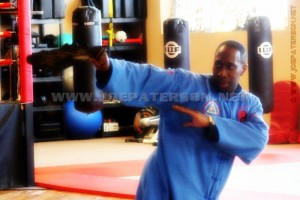A brief History of Taijiquan
Place content here and below…
“Poor Quality recording but shows the essence of movement…”
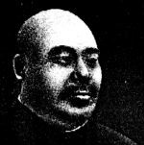
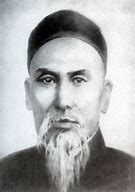
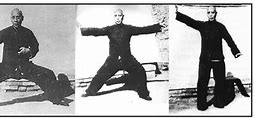
In Taijiquan, the ability to cultivate oneself physically and spiritually, but not to defend oneself,
is civil accomplishment. The ability to defend oneself, but not to cultivate oneself, is martial
accomplishment. The soft Taiji method is the true Taiji method. The ability to teach the art of self cultivation
and self-defense, both cultivation and application, is complete civil and martial Taiji.
Yang Lu Chan’s own boxing was so soft that it was nicknamed cotton fist or neutralizing fist and
was once berated as not being combat effective because of its softness, a point which Yang
refuted by promptly defeating the antagonist .
COMBAT YANG TAIJIQUAN
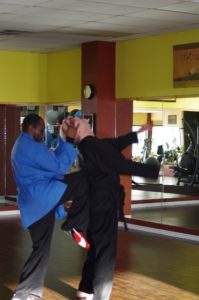
Bu Tiu Bu Ding: Not Letting Go, Not Resisting
This combat principle is first cultivated in Push Hands practice and later refined in San Shou practice.
The key element in this principle is nian or sticking and it operates through nian jing or sticking jing.
This is because without sticking, one cannot hear the opponent’s energy and its qualities and so be able
to control them effectively. And if we resist then we give the attacker a base for which to effect his
attack.
That is why instead of deflecting, resisting and absorbing an opponent’s attacking force, Taijiquan
exponents evade, redirect and blend with it. Evade means simply to move out of his way. In any attack,
there are only limited points of attack, so simply removing yourself out of his attacking focus by a
change of position negates it. Upon contact, it is not a hard block but a blending with the attacking part
by yielding, sticking and following his momentum, joining his energy and redirecting it to your
advantage.
Through Nian Jing or “sticking energy” we can then develop Ting Jing or “listening to energy” which
is the sensitivity to detect the opponent’s strength, its origin, trajectory, magnitude and component
vectors. Once we are able to detect his energy movement and his center of mass, we can effectively
know his intent and control it by affecting the energy flow and center of mass efficiently.
Sui Ren Zhi Shi, Jie Ren Zhi Li: Following His Posture, Borrowing His Strength
This simply means to follow your opponent’s structure and adapt to it so that it is ineffective. This is
practical application of the principle of Bu Tiu Bu Ding by yielding and following him. Rather than a
rigid application of postures learned, the postures occur spontaneously in response to the opponent’s
structure.
Borrowing his strength is essentially utilizing his own strength against himself, either by causing it to
over extend or to channel it through your own body structure back to him. He is literally then hitting
himself and there is little expenditure by way of energy for the Taijiquan exponent.
This following of the opponent’s structure is first learns from Push Hands, which is why it is
important that it not degrade it to a choreographed exercise. Sensing the movements and responding to
them is correct rather than just going through the motions and not sensing them. If he does not move,
you should not move, but even static, there will be structural flaws that can be detected by the touch
and one can attack them by moving first. But be always aware of a possible trap, even during an attack,
sensing plays a very important role in avoiding traps by responding in mid-attack and countering the
trap.
Yin Jing Ru Kong: Attract Into Emptiness
Literally it means “attract into emptiness”. It is one of the most common tactic used in Taijiquan and
is exemplified by the posture Roll Back which implements the opponent’s entry into emptiness. The
tactic essentially is presenting a false target for the opponent to attack and when he does, you spring the
trap of letting his own momentum and mass be his own undoing by overextending it. Finding no target,
he is naturally unbalanced and is easy to counter.
Fa-Jing: Emitting Energy
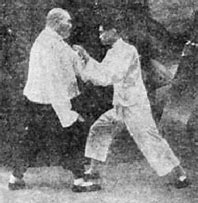
This is when the Taijiquan exponent attacks, it refers to the emission/transmission of energy out of
the exponent’s body and into the enemy or target. The whole process is of an explosive nature but at no
point in it is the body or limbs rigid. Taijiquan exponents are noted for their great power when it comes
to uprooting or bouncing an opponent out. This power, however, is applied appropriately and
efficiently. Having a lot of power but not knowing where to use it is quite useless, hence the importance
of sensitivity. Sensitivity allows one to not only know the opponent and avoid his power but also know
where to apply yours to greatest effect.
So is the appropriate use of great power then the key? No it isn’t. Power in excess of what is required
to achieve the neutralization and control is inherently unstable. Refining the process till it becomes so
efficient that minimum power can produce maximum effect. Then even an old man can best a young
and strong one, not with more power but with the intelligent and efficient application of the body.
That is why masters like Zheng Man Qing can send a 200 pound man flying across the room but can
find a bowling ball too heavy for him to carry on with the sport (example taken from Mr Lowenthal’s
book on Master Zheng). The seeming paradox is no paradox at all once one understands it.
Chang Jing: Long Energy
This is the most common type of energy emission used in Taijiquan. It develops from the feet and
because the energy path is long, through all the joints and ending at the fingers, it is called Long
Energy. It is commonly seen when Taijiquan exponents bounce out their push hands partners. The
whole body of the opponent is physically pushed away by moving his center of mass. If it is done
correctly, both his feet should leave the ground when he is propelled away. This is why the technique is
called uprooting.
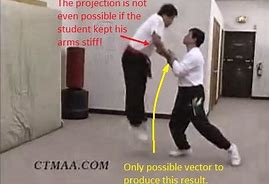
The energy can be developed from the rear foot, the front foot or from one to the other. All the joints in
the body work coordinately and smoothly without tension to transfer, amplify and focus the generated
energy to the point of attack. This type of energy is usually the first to be manifested by the exponent
and though it can be spectacular, it does not cause very serious injury.
Duan Jing: Short Energy
This type of energy emission is less common and is considered a rather advanced method. The energy
transmission path is shorter than that of Long Energy and originates at the center of mass which is
supported via the rooting leg. The energy emission begins at the center of mass and propagates
outwards. Down the root and out through the limbs. It is targeted on and acts upon the center of mass of
the opponent directly, using it as a base for a crushing attack that ruptures organs, rends musculature
and breaks bones.
The fastest application of such energy is called Leng Jing or Cold Energy. The reason it is called this is
that the emission was so sudden that it catches the opponent by great surprise, so great it became fright,
causing him to break out in cold sweat.
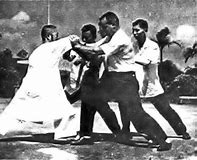
Jie Jing: Intercepting Energy or Receiving Energy
This skill has always been associated with the great masters and we know that Yang Lu Chan and more
recently Yang Cheng Fu and his disciple Zheng Man Qing possessed this skill. It has been said to
border on the mysterious and is hard to attain such skill. This skill can only be attained after one is
learned in the feet, inches, tenths, hundredth parts and thousandths parts in Taijiquan. At lower levels of
attainment, jie jing is expressed mainly through the hands, at higher levels where the entire body is
responsive then it can be expressed from almost any part of the body.
What this skill really means is that with an incoming object at speed, the body or contact point, by
sticking and yielding attains almost the same speed as the object. This means that since the acceleration
of the object and the contact point is nearly the same, their relative speed to each other is small. By
listening to the object’s center and vectors, an appropriate minimum vector can be applied to change
the object’s trajectory. If it is a balanced object, it can be easily pushed, if it is not it can be easily
redirected. This is what Zheng Man Qing meant that in Jie Jing one must first attract the object first
then throw it away.
Feet, Tenths, Hundredths Parts And Thousandths Parts
This means the division of each movement in Taijiquan into ever finer gradations of movement,
technique and jing flow. Each part is then meaningful and has an application in a combative context.
The refinement of movements to efficiency is but the beginning, later each part of the movement itself
has meaning and later each part of every part and so on.
This practice also ensures that the mind is conscious of every part of the movement and every tiny
movement of the body. Sensitivity is thus trained to a very fine degree as is the response to such minute
stimuli. As the Classics state the goal quite clearly, to be so light and sensitive that a feather cannot be
added nor a fly alight.
The Four Advanced Yang Taijiquan Combat Skills..
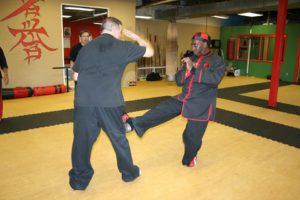
Taiji Boxer in action Oblique stop kick
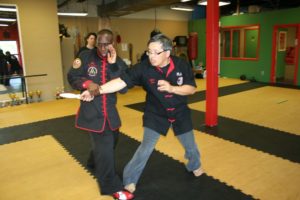
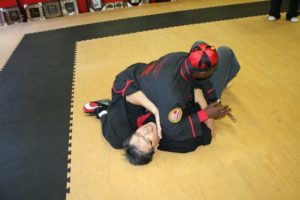
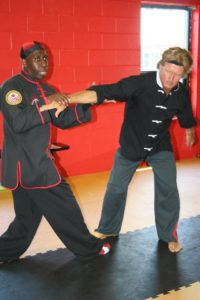
There are situations where the skills and principles above require some augmentation to make them
even more effective. This is usually where the opponent’s skill level is high enough so that an effective
counter is not possible using less injurious means. With such situations stronger discouragement is
required and to cater for such eventualities, Yang Taijiquan has four advanced combat skills. These four
skills can only be learned and applied effectively after one is able to understand each individual portion
of any technique. In other words, one must be able to comprehend and put into practice the feet, tenths,
hundredth parts and thousandth parts in Taijiquan. These four skills are recorded in the handwritten
manual handed down from Yang Lu Chan. It must be noted that the four skills are not used entirely on
their own but are integrated to form a comprehensive system of attack and defense built upon the basics
of stability, sensitivity, agility and efficient use of the body and energy.
Bi Xue: Sealing Accupoints
This is also known as Hitting Accupoints and is more commonly known among Chinese martial
artists as Dian Xue or Dotting Accupoints because the majority of these kinds of attack make use of the
fingertips. Attacking Accupoints is by no means unique to Taijiquan but the way it is done is certainly
quite unique. Whilst other martial arts often make use of serious conditioning of the anatomical
weapons and vigorous body conditioning to develop the strength and resistance required to hit
Accupoints, Taijiquan uses positional and structural advantage to let the opponent provide the power to
hit himself with his own power and mass.
Accupoints are divided into fatal and non-fatal accupoints. Fatal accupoints are only used in a life and
death situation as they are cause death very quickly and should not be used indiscriminately. Non-fatal
accupoints are used to simply disable or incapacitate the opponent without causing too much harm.
There are also accupoints that are more effective at different times of the day depending on the Qi flow
in the body. These timed strikes are of a more insidious nature as they are used for delayed killing or
assassinations.
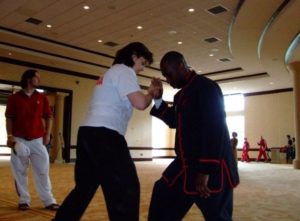
A short list of some of the accupoints used in Taijiquan is provided but readers are advised against
using them unless absolutely necessary and to refrain from experimentation as the recovery techniques
should be properly understood before one should practice with accupoints. Even then it is advisable not
to practice them with any sort of impact since any Accupoints strike on the body is a severe disruption
of the body’s systems and will have an affect on health of the body, both in the long term and in the
short term. In most cases, even after remedial massage and Accupoints treatment is carried out, herbs
are taken to strengthen and stabilize the body in order to eliminate any after effects.
Grasp Sparrow’s Tail:
• Peng (Ward-Off)- Wrist and forearm points (LI 4/5/7/10/11, SI 6/7, Lu 5/6/7/8, H 2/3/6, P 6, TW
5)
• Lu (Rollback) – wrist and upper arm points (TW 11/12, LI 13, P 2)
• Ji (Press)- center of chest (Ren 15/17, K 23, and flank, Liv 13/14, Sp 21, GB 24)
• An (Push)- ribs (K 23, St 19) and floating ribs (Li 13/14)
Zhua Jing: Grasping Muscles
Grasping musculature in Taijiquan is akin to the specialization of Chin-Na (Grasping and Holding)
which is an advanced skill in many forms of Chinese martial arts. The difference is that in Taijiquan,
the use of positional advantage, momentum and structural advantage is of more importance than super
strong fingers. The sensitivity of combat Taijiquan permits the use of the opponent’s structure, position,
mass and momentum against himself causing him to literally lock and tie himself up with his structure
with the Taijiquan exponent simply helping him do it.
The result of this is that his body is unstable, rendering him vulnerable to serious injury should the the
Taijiquan exponent chooses to do so. The locks and holds also cause sprains, tears of the musculature
and dislocations of bones at the joints which further disable the opponent.
Jie Mo: Sectioning Fascia
This skill is directed at restricting blood flow so as to render the body ineffectual in the execution of
attacks. This is done primarily by structural control so that the position and state of the musculature and
soft tissues of the opponent are such that the blood flow to certain parts of the body is restricted. Blood
flow pressure points or gate points as they are referred to in Chinese are also used to effect this. This
can cause the limb to go to sleep or cause a knock out. Also part of this skill is the restriction of air flow
by attacking the respiratory system and the musculature that powers it. Strikes are sometimes used to
effect this.
Positional and structural advantage and use is essential to restrict and control his body. This is
possible to a fine degree through the tactile sensitivity attained through diligent practice in
pushing hands and sparring hands.
Na Mai: Holding Vessels
This refers to the grasping, holding and pushing of the Qi meridians and accu points with the purpose of
disrupting and controlling the Qi flow in the body. This makes the body impaired in terms of function
and movement rendering the opponent vulnerable. Where Grasping Muscles attacks the physical
structure of the body and Sectioning Fascia attacks the circulatory system, Holding Vessels attacks the
internal vital energy flow which is distinct from the accupoints and the striking of them.
A good knowledge of the body’s Qi meridians is necessary as is the results of their disruption and
blockage. As with the above skills, the opponent own body and energy is used against himself through
superior information via tactile sensitivity and appropriate efficient application to obtain the desired
result.
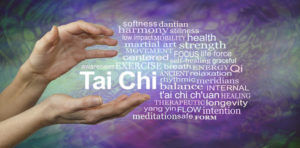
Healing And Harming.
When one can destroy a thing, one controls a thing. The knowledge and skill to cause destruction and
death of the body can also be used to restore health and prolong life. The four advanced skills
mentioned briefly above all require a thorough and intimate knowledge of the body and its functions.
This knowledge can be used to heal injuries and illnesses by opening blockages to Qi and blood
circulation, restoring proper musculature position and function.
Often, this healing function is learned first before the harming function is taught. This ensures a proper
disposition and respect for the skill as well a firm grounding in the theoretical base and its practical
application. It is because these skills are so destructive that they are seldom taught and a large
proportion of exponents in the art are not aware of their existence. They are passed on only to the most
trusted of disciples who will not abuse them but use them for the benefit of all mankind.
The Taijiquan Martial Artist
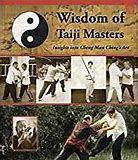
Above all, Taijiquan exponents are encouraged to be moral people. A sense of righteousness, chivalry,
kindness, compassion, nobility and being a benefit to society should always be the code of conduct for
a Taijiquan practitioner. A good example of a moral Taijiquan exponent will be the great master Sun Lu
Tang who was not only a great martial artist but also a great man. A practitioner should embody the
principles of his art and apply its stratagems and philosophies in their dealings with all things.
The aim of Taijiquan as a martial art is to stop violence conclusively
without recourse to more violence, most of the time the violence is redirected against
itself or rendered ineffectual. Hence Taijiquan exponents usually just overpower their opponents by
turning their own violence against themselves, educating them rather than hurting them. Violence
begets violence but by making violence not an option by rendering it pointless, since in Taijiquan it acts
against itself, the destructive cycle is broken and a more rational, less confrontational solution becomes
the most effective.
Can Taijiquan be used as an attacking art? Yes, but violence should only be the last recourse, never the
first. Ego has no place in Taijiquan as it gets in the way of efficient practice and usage of the art.
Violence is seldom the solution to a problem and all life is precious and should be treasured. Taijiquan
itself is an art to prolong life, in peace and in combat. In practicing Taijiquan as a combat art, peace is
learn and cherished. We learn the art that we may never have to use it. That with the knowledge of
violence and its consequences, we choose to avoid it.
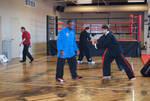
Peter Lim Tian Tek — Singapore
It is wisdom to know others; it is enlightenment to know one’s self
— Lao Tzu (6th century BC)
This is a summation of most of the classical principles for TaijQuan as a martial art.
I hope you enjoy it…
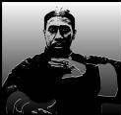
![]()
The lost art of Taijiquan and other Traditional fighting systems
 Many people have in recent days been attracted to the glamor and bravado of the U.F.C. fever. Even to the point people whom have a legacy of traditional heritage of martial arts are now forced to jump on the bandwagon of so called mixed martial arts training. This is very sad to see.
Many people have in recent days been attracted to the glamor and bravado of the U.F.C. fever. Even to the point people whom have a legacy of traditional heritage of martial arts are now forced to jump on the bandwagon of so called mixed martial arts training. This is very sad to see.
Things have gotten so bad the first original martial arts media giants, such as Black belt magazine, Inside Kungfu, and Taijikungfu Magazine are no longer visible on the shelves of Chapters book store under SPORTS. Instead, you have U.F.C. and Grappling Magazine.There is nothing wrong with adding to what you already know, but to trade it in for a cheaper newer model is not always wise or prudent. New does not always mean better, just different for a time. Remember the deception of this so called” mixed up martial arts” is exactly that!!
“User of many master of none” I think that every traditional system when taught in the context of it practical environment has for more depth than dabbling in Brazilian Jujitsu, Muay Thai kicking style and American Kickboxing methods.
Give me a good traditional 10 year veteran in Penjat Silat or Hwrangdo, Korean martial arts, or classical Chen style Taijiquan or Taijjitsu player, open up the ring throw in some good old fashion Capeorio, and see who would fare the best in a friendly tussle.
Anyway for more interesting thoughts, check out my web site and www.youtubedpounall.
NEW!! – TaijiBoxing Seminar in Kitchener – NEW!!
Click Here to Download the Poster
Click here to read my latest article…
 I am Dennis Pounall, a dedicated soul, bound to my craft of Taiji Boxing and Martial Arts. I am available by appointment for on-site seminars and workshops. Please feel free to browse the testimonials and contact me at any time.
I am Dennis Pounall, a dedicated soul, bound to my craft of Taiji Boxing and Martial Arts. I am available by appointment for on-site seminars and workshops. Please feel free to browse the testimonials and contact me at any time.
Join the forum discussions, view the blogs, let me know who you are…. Enjoy.
Welcome to my site.
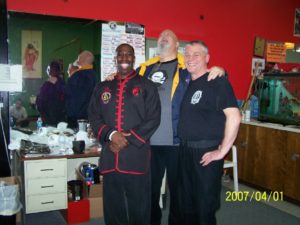
“3 wise men”
My name is Dennis Pounall, and I recently had the privilege to teach a workshop in both Kitchener, Ontario and Kingston, Jamaica.

whirlwind fan form” both were well received at Kitchener kicks Martial arts center
The first workshop I had been invited to was last Christmas in Kitchener Ontario, at Sifu David Hackett School
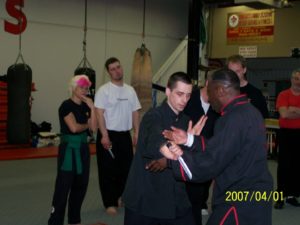
`Kitchener Kicks Martial Arts Center`, a classical beautiful Dojo with original wooden floor, lots of natural light and high ceiling.
“The Art of Effective Kicking Super Dave Hackett ‘
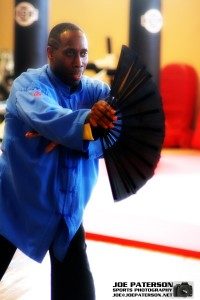
I demonstrated the Tsunami Whirlwind Fan form. and they loved it. I was then asked by sifu Dave to teach it to his students, I was honored and happy to oblige. This is a very eclectic fan form and is different as it combines principles from three different disciplines. Korean fan form, Shaolin fighting fan form and Japanese Samurai Tessan applications.
This form can also be modified to display aspects of modern Whusu or for older practitioner a more subtle Taiji approach. all round great weapons form.
The workshop started off with the usual pleasantries, greet and meet, quiet informal and then we began with some basic Qi kung “Standing Jong Posture” . We then progressed with some stretching breathing and general history usage and function as both a weapon and tool for learning how to extended ones Qi and awareness , which is essential for all weapons play.
It is important to understand form, function and feeling when attempting to learn any martial discipline, so for each movement there is a technique ,and every technique has a specific quality of movement.
The form was taught slow, connecting each movement until every one had a fundamental meaning for each one of the movements. Then we would practice a application and have everyone create their own techniques. This I believe adds some
substance to the art and depth to the practice of the Fan form
-
“The eagle spots it prey”
- “white snake sticks out its tongue “
Each participant had an opportunity to share their understanding with the group , and lots of practice. We were fortunate that the whole group was a nice mix from different backgrounds giving the form more of a universal flavor and natural rhythm.
At the end everyone was granted a certificate and picture as a commemorative of the experience.
- Tsunami fan form seminar
-
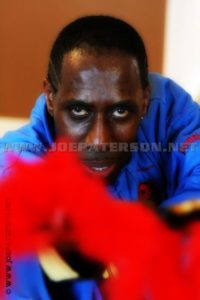
I hope everyone was able to appreciate the beauty of the Fan form and its unique ability for freedom of personal expression. This to me is what makes a true martial art!!
-
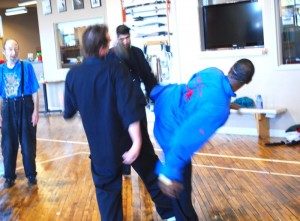
- You move fast I move faster!
The next workshop was called the “Art Of Effective Kicking”. This concept was really about trying to share the idea of “Tai Subaki” and “Range control”, not at all aimed at fancy double or triple kicks, which most people, including Hollywood movie producers want us to see.
For those that are interested, check out “Scorpion Kick on You Tube” The whole idea, I believe, when using your legs is to prevent further injury, get out of the way and best of all `run away”. Kicking is just a side effect of maximizing range control. The legs are much more powerful than the arms and kicking is a natural movement to all human beings, for instance , babies are already kicking in their mothers womb. This is one of the natural signs of a healthy baby.
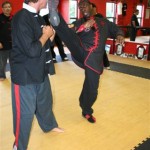
Even in Taiji Quan, or Taijiboxing as I refer to it as there are lots of kicks, some are more obvious than others. However Taiji Quan, unlike other disciplines, use the art of foot placement and range control to make sure when and if you do kick it will be effective. Every martial art has some form of kicking but Taiji style tends to be more subtle but just as effective.
We practice only the basic kicks as usually that is what you would really use and these kicks were most effective for self defense and personal protection. It is always a good idea to have a variety of kicks you can do but always understand their advantages and weaknesses.
-
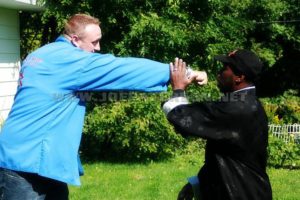
- “Bigger the are the harder they may fall.”
Then you always have an option. We focused on low kicks to the joints, knee, hip, shin, and instep. We also made sure to work both sides and within each participants comfort and skill level. We explored all angles and different parts of the lower leg and feet, as to how to strike, where to strike, and when not to strike to reduce the chance of permanent self injury. All in all we had a good sweat and a lot of fun!!.
-
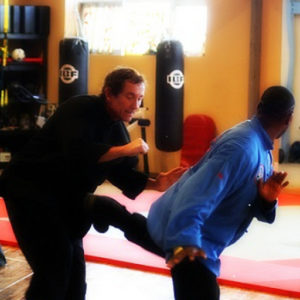
- “retreating back kick“
This was a great learning and sharing experience for both parties involved. As much as Taijiquan is still portrayed as mostly an exercise program for seniors, the inherent martial applications and the wisdom of the ages still rings through even modern times. The principles are transferable regardless of the martial discipline in which one participates in. The true art is in the willingness to share knowledge and experience.
-
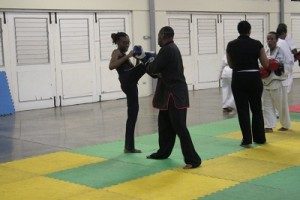
- A warm Greeting From the Sunny Island of Jamaica
Seido Juku Karate is- in concept and in practice – based on a deep understanding of the spiritual aspect of karate, which is why Kaicho calls Seido Karate Ningen Karate or the Human Face of Karate. Master Tony Robinson states the origins of the school is based in traditional kykoshin karate do therefore it has a more aggressive hard style and although they new about KI , or Qi force they understood it only from a external point of view.
-
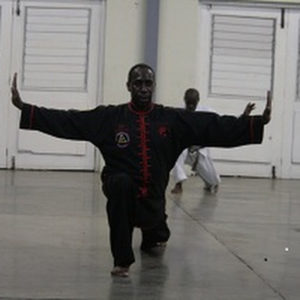
- “deep slow stretching of the illopsoas, muscles helps to prevent injury before kicking ‘
Consequently the school curriculum and principles were founded more of a sport Karate for basic self defense and fitness. So he was quiet intrigued by the principles of Taijiboxing and I was happy to see taught meditation and breathing was a important part of their training regardless of rank.
They began with a formal Introduction then the classes was turned over to me. I did some traditional warm ups but included some basic Qi gong, Embrace the one, and some Yoga style stretches. It was well received by all . We then began basic striking then we worked on the art of effective kicking.
-
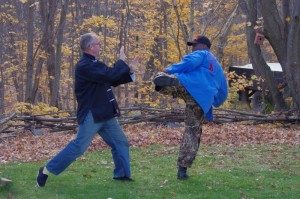
- “You attack low I will defend high” ‘
They were not familiar with this concept or range control, so I taught them using the principle practice slow to move fast, which Master Robinson loved to hear from another source. We were all hot sweating and tired. and I found by using the Taiji breathing technique I was able to persevere precious energy and fluid and finish the class.
We then broke up into two lines, they did some light contact free sparing, then after wards we all drank coconut water and ate some fruit, drank more water for re hydration and fluid balance.
The class was concluded with a formal closure of bowing and respect to each of the instructors as was the tradition, and five minutes of sitting Za Zen Meditation.
All in all, this was a great opportunity to share grow and learn and to see no matter where you are the principles of Taijiboxing be absorbed and assimilated by any system martial arts.
Maybe this is what was secretly meant by the title of Supreme Ultimate Fist, Possibly it may have had nothing to do with being the best system of martial art, but maybe the most versatile.
I hope you enjoyed this little adventure as much as I did and thank you for reading. Have a great day and remember at the end of the day every thing will be cool running, yeah mann! Peace
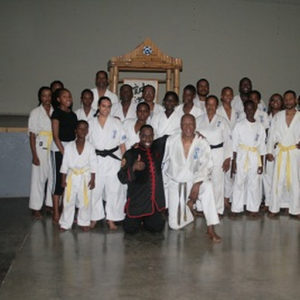
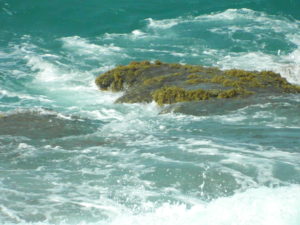
- yeah mann! Peace
Synthesis
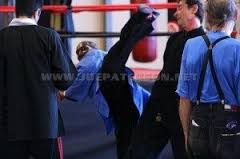
(and the Supreme Ultimate Fist of Taijiboxing)
Use the art of foot placement, and range control to make sure when and if you do kick it will be effective!
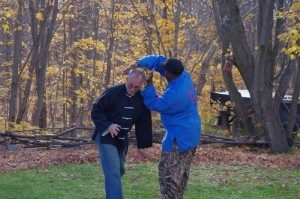
The term synthesis is used in many fields, usually to mean a process which combines two or more pre-existing elements resulting in the formation of something new. The verb would be “to synthesize” meaning to make or form a synthesis.
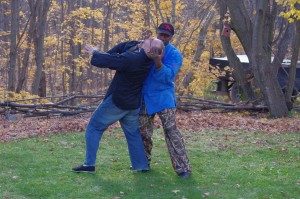
Taijiboxing is both a discipline and an art form, and has multiple levels of expression and is popular worldwide. It is renowned for its many preventive disease benefits as well as it numerous natural health benefits. It can be practiced by young and old, strong and weak, in sickness and in health. Both the rich and the poor can glean the benefits from this ancient discipline.
But what sets this discipline apart from the many other forms of exercise and martial arts systems? I believe that, within the practice of Taijiquan, is the unique availability of self-guided, on-going development, allowing each practitioner the ability to continually improve, share, and grow as they age in life, in mind, in body, and in spirit…
This unique trait makes Taijiquan practice, principles and application unlimited and timeless, making it, in a sense, the supreme ultimate, as it is limited in potential only by the boundaries of each practitioner.

Consequently, it never grows old and is never in or out of style. This, unlike most martial arts disciplines, allows this system to be both universal and also international. With each new generation of Taijiboxer comes the refreshing of the old wisdom becoming the new rediscovered knowledge.
This concept of natural transmission through the spoken word, and to learn by doing is quite foreign and difficult to sell in today’s fast-paced, information age, and the modes of transmission are much more difficult to negotiate. As the world turns and our universe appears smaller, our full awareness of self also gets distorted. We focus on technology and over-consumerism. Our feeling is continuously pacified
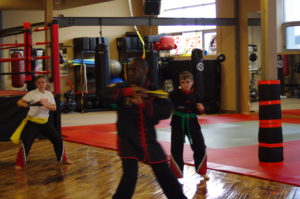
and we are disconnected, first from our true self (the concept of a higher power, God, Buddha, Jehovah, Ala, nature), then from each other, our family and our friends, then our neighbors, relatives, and work acquaintances. This creates a subdued feeling and sense of isolation, … and a society of shut inns.

Everyone believes their only mandate is to foster a sense of survival, and life becomes a constant struggle to survive, and very few people actually live.
“Golden rooster stands on one leg”
The essence of Taijiboxing is found in Buddhism, which is all about “compassion and sharing”, and the fundamentals of Taoism, which promotes “self awareness, and interaction and understanding of universal cycles of cause and effect, and the collective cooperation between man and his universe to promote longevity and maintain harmony on the planet.
These two concepts enhance universal, compassionate enlightenment with a sense of immortality of the spirit. These transcend the boundaries of mind and body, therefore, we no longer struggle with death, dying and diseases, which are all natural processes. But with a caring, compassionate lifestyle in harmony with your environment, you know and can choose to embrace life, and nurture the supreme, ultimate gifts found within the daily practice of Taijiquan.
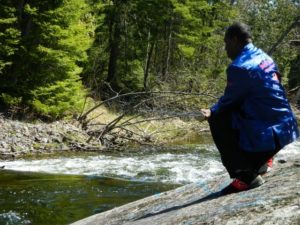
Synthesis is the unseen ability to draw from your past, present, experiences and future in intuitive knowledge and observations. These concepts give you the unique ability to create an alternative solution to any given or unforeseeable conflict.
This ability in some people may be innate, but, in most, is learned, and in a few individuals can be developed. The ancient Taiji master must have discovered a method of harnessing this truth and applied it to their daily life. This wisdom was applied in both physical conflicts and in everyday life experiences on the journey of life…
This gift was sometimes passed on to a chosen few, but, in most cases, died with the master, or was never fully transmitted. For this reason, Taijiquan is still the supreme ultimate fist, and awaits the reincarnation of the gifts of the masters for all to benefit. (It’s hidden in plain sight.) The essential aspects of synchronicity are the applications of the five phases of Taijiboxing.
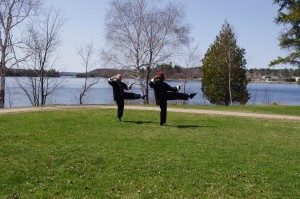
1. stillness in motion and motion in stillness.
2. “Silk reeling skill” and Synchronicity and “Economy of Motion”
3.Chi Na in (5 levels )
4..Fa Jin and Chi kung
5. Shuai Jiao
These concepts, when integrated with meditation, healthy living, a wholesome, varied diet, and a natural zest for life, help to maintain Taijiboxing as one of the supreme ultimate gifts left by the ancient Taoist Sages..
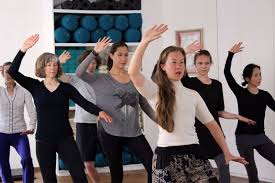
In conclusion Taijiquan and Taijiboxing have a synergistic approach to maintain a healthy, vibrant attitude to life and living. The philosophy and discipline, found in the application of Taijiboxing principles to everyday living, helps to maintain an open and free- flowing mindset of synthesis that allows for spontaneous, flexible options to living a full, happier life.
I hope you enjoy my article. Please feel free to comment and leave your ideas and observations. Keep the information flowing..
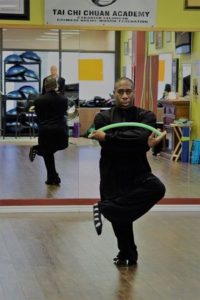
Sifu Dennis Pounall
\



